Do you have a decent idea for an app and need to know “how much does it cost to build a web application”?
Drawing on more than ten years of experience as a leading web development agency with clients around the world, we've found that most web app projects take between 1 to 6 months to complete, with costs usually falling between $5,000 and $30,000. But this is a very average estimate and many of our clients have spent $100,000+ to create the applications of their dreams.
In this article, we will tell you how to estimate your future web app and what factors affect the cost.
At Greenice, we're experts in crafting cost-effective web apps tailored to your business needs. Since 2007, we've successfully completed over 200 projects across various industries, proving our versatility and expertise.
What is a web app?
A web app is software that works in a web browser (e.g. Chrome, Safari, or Bing). This software uses web technologies like HTML, CSS, and JavaScript, with frameworks, libraries, and databases. Unlike traditional websites that display mostly static content, web apps engage users with interactive functionalities, processing and updating data without reloading pages.
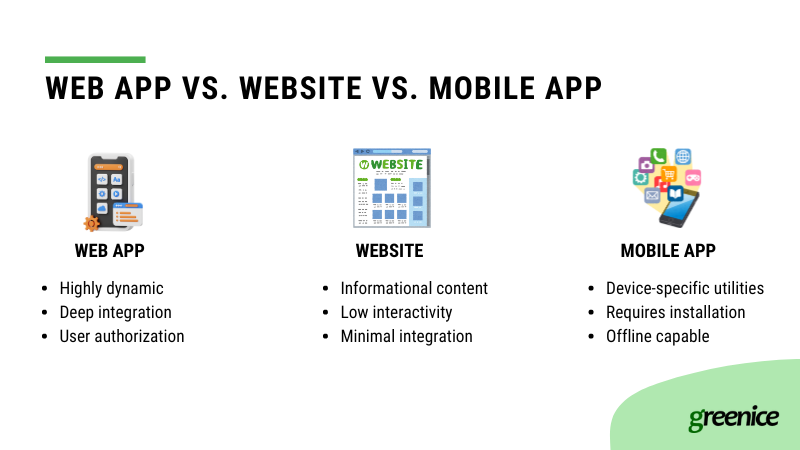
Web app vs. website
Websites are traditionally defined as collections of publicly accessible, interlinked web pages under a single domain name. These are primarily informational and static, designed to provide content that does not change unless it is updated by the webmaster. For example, company pages like Greenice.net (you are here).
Web apps are dynamic and interactive, designed for user engagement and active participation. This includes applications like YouTube, Gmail, or Twitter (sorry, X).
Let’s compare them side to side:
- Interactivity: Web apps are inherently interactive, often requiring user input and involvement, which influences the content and functions of the app. Websites, traditionally, were more about providing information without much user interaction.
- Integration: Web apps frequently integrate with other systems like CRM, ERP, or third-party services to enhance functionality, whereas traditional websites might not need such integrations.
- Authorization: Many web apps require users to create accounts and log in, offering a personalized experience based on user data. While some websites now also require authorization, it is more central to web apps due to their interactive nature.
However, the difference between websites and web apps is getting increasingly blurred. Websites have evolved significantly and now incorporate dynamic content, interactive elements, and backend complexities that were once exclusive to web apps.
Both platforms aim to offer seamless, engaging user experiences with minimal loading time and high responsiveness, further complicating the distinction.
Web app vs. mobile app
Mobile apps are installed on specific devices and may utilize device-specific features. Web apps run in web browsers and don't require installation. They can be accessed from any device with a browser, offering broader accessibility and ease of update. Mobile apps require updates through app stores and are platform-specific.
Developing web apps is often more cost-effective and simpler since they use a common codebase across platforms, unlike mobile apps that may need different versions for iOS and Android. At the same time, mobile apps are faster and can use more phone features (like camera, GPS, and calls).
Web apps provide a universally accessible, easy-to-update solution for interactive applications, making them an efficient choice for businesses aiming to reach a broad audience without the complexity of platform-specific development.
Types of web apps
Web applications come in different forms meeting different user needs and technological capabilities. Web applications can be broadly categorized into Multi-Page Applications (MPA), Single Page Applications (SPA), and Progressive Web Apps (PWA). Understanding these types helps in choosing the right approach for your specific needs.
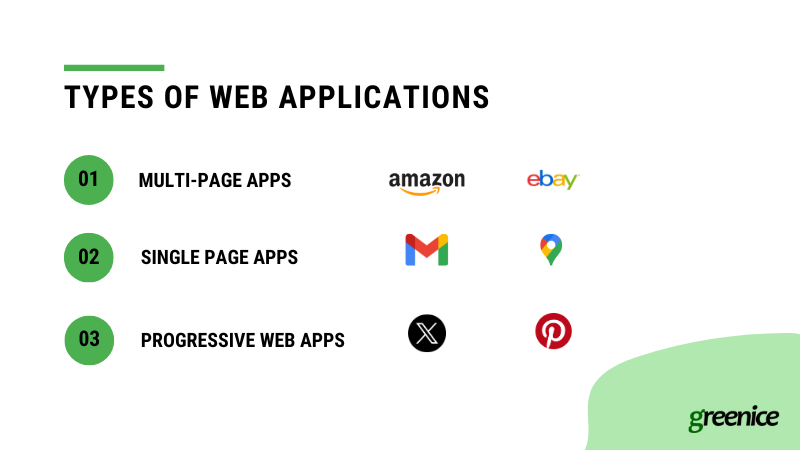
Multi-page applications (MPA)
MPAs are traditional web applications where each action or request from the user loads a new webpage. This process involves going back and forth between the server and the browser, which can slow down the user experience but is beneficial for SEO and scaling.
Large eCommerce sites like Amazon and eBay or extensive informational sites like online forums and blogs typically use this structure.
MPAs are:
- SEO-friendly: Each page can be optimized individually for search engines.
- Scalable: Suitable for large sites with many pages and extensive content.
- Structured: Organized navigation with distinct pages for different topics or features.
Single page applications (SPA)
SPAs load one HTML page and update it dynamically as users engage with the app. This method prevents disruptions in the user experience when moving between pages, giving the application a desktop-like feel.
Modern web apps like Gmail and Google Maps, and social media platforms such as Facebook benefit from SPA technology to deliver a seamless user experience.
SPAs have:
- Fast transitions: Offers a smoother and quicker user experience after the initial page load.
- Reduced server load: Minimizes server requests by only loading the content that changes.
- Enhanced user engagement: Keeps the user in a single, continuous user interface, which is ideal for interactive applications.
Progressive web apps (PWA)
PWAs combine the best attributes of web and mobile apps. They are designed to work on any platform that uses a standard-compliant browser, including both desktop and mobile devices.
Platforms like Twitter, Pinterest, and Spotify have adopted PWA technology to enhance user engagement and accessibility.
PWAs offer:
- Offline mode: Can function without an internet connection using cached data. Device flexibility: Works on any device with a standard web browser.
- App-like experience: Mimics native mobile app behavior, enhancing usability.
- Push notifications: Supports re-engagement with users through system notifications. Resource efficiency Uses less data and storage space compared to native apps.
Now, let’s figure out how the app type affects its cost.
How the type of web app influences costs
The nature of the app affects its price. Static apps are much easier to create, making them significantly cheaper than dynamic ones. At the same time, additional features add up to the cost. This is especially true for progressive web apps as they often have advanced functionality.
Here’s a detailed look at how the complexity and type of web apps influence pricing:
- Multi-page applications: Usually start with moderate costs due to their standard web setup. However, costs can rise as more pages are added, each needing its own design and upkeep. Also, if the app needs to be optimized for search engines (SEO), it involves extra work and cost to ensure each page ranks well.
- Single page applications: Higher initial cost due to the need for advanced front-end frameworks, but can reduce long-term server costs.
- Progressive web apps: High initial development costs due to the need for advanced features and offline capabilities, but offer long-term benefits in user engagement and cross-platform functionality.
As you have guessed progressive web app development cost will be the highest compared to other options.
Average cost of web application development
The cost of developing a web application varies widely. Based on our experience as a web development agency web app development usually takes from 1 to 6 months on average and costs between $5,000 and $30,000. But complex solutions with advanced features can easily outgrow $150,000 and even reach $1,000,000.
When considering the development of a web application, it's useful to look at examples of well-known applications and the features that can influence their development costs.
Web application development cost breakdown examples
Here's a deeper exploration of what might affect the cost of developing complex web applications like multi-vendor marketplaces, SaaS CRMs, and streaming services.
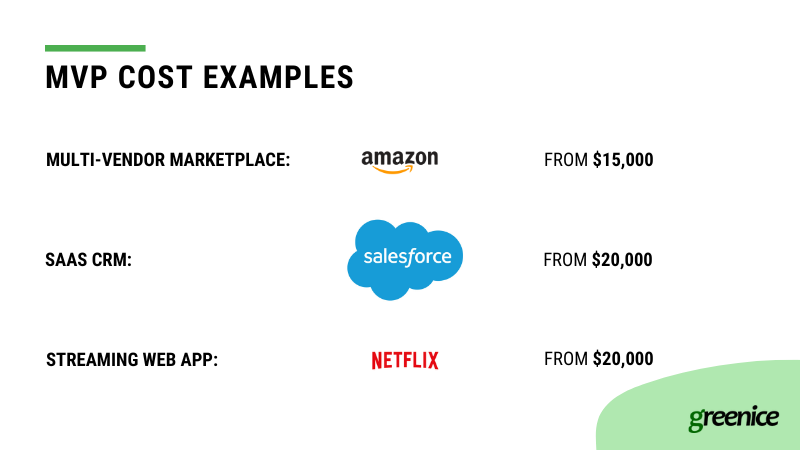
Multi-vendor marketplace like Amazon
Developing a multi-vendor marketplace such as Amazon involves intricate features and multiple user roles that can significantly impact the cost:
- User roles and interfaces: Typically, there are at least three user roles: general users (buyers), sellers, and administrators. Each role requires a unique set of functionalities and interfaces. For instance, sellers need tools for listing products, managing inventory, and viewing sales reports, while administrators require robust dashboards for overseeing marketplace activity and user interactions.
- Real-time inventory management: Implementing systems that can handle real-time inventory updates from multiple sellers adds complexity and cost. This involves back-end logic to ensure that inventory levels are updated instantly across the platform as sales occur.
- Complex search algorithms: Developing advanced search functionalities that allow users to filter through millions of products based on various criteria requires sophisticated algorithms, which can be resource-intensive and costly to develop.
- High-level security: Ensuring data protection for both buyers and sellers, especially in handling transactions and personal information, necessitates advanced security measures, further increasing development costs.
Initial setups can start from $15,000, but more comprehensive systems with high scalability and security can easily exceed $100,000. Beware that this price is estimated for an MPA, while a progressive app will be more expensive due to its complexity.
However, there is a way to cut the costs by using white-label solutions. In this case, the initial price can start from $5,000 for an MVP. If you want to learn this option in detail - we’ll explain it further in the article.
SaaS CRM like Salesforce
A SaaS CRM platform, such as Salesforce, requires extensive customization options and data analytics capabilities:
- Core CRM features: Basic customer relationship management functionalities include managing customer profiles, tracking interactions, and maintaining communication histories. These are essential for any CRM system and form the base of development costs.
- AI analytics: Integrating AI to offer predictive analytics, customer insights, and data-driven decision-making tools can significantly increase costs due to the complexity of the algorithms and the required data-handling capabilities.
- Scalability and integration: As businesses grow, the CRM must integrate seamlessly with other tools and scale to handle increasing amounts of data, which can complicate the architecture and raise costs.
A basic version could start around $20,000, but with advanced features like AI analytics, prices can surge above $100,000.
Streaming web app like Netflix
Creating an SPA for a streaming service like Netflix involves multiple features required for a seamless user experience across various devices:
- Content delivery network (CDN): Utilizing a CDN to distribute content globally ensures fast and reliable access to videos, essential for a smooth streaming experience.
- Multi-platform accessibility: Designing the app to function across multiple devices (TVs, smartphones, tablets, PCs) increases development complexity and cost.
- Personalized content algorithms: Implementing algorithms to suggest content based on user behavior can enhance user engagement but requires advanced machine learning techniques.
- Robust security measures: Protecting user data and preventing unauthorized content access is crucial, necessitating high levels of security in development.
Basic streaming functionalities might start at around $20,000, but adding features for content personalization, multi-device support, and superior video quality can push costs further.
Factors influencing the cost of a web app
The cost of developing a web application varies based on several critical factors. Understanding these can help you better manage and anticipate the expenses involved in creating a robust, functional web app.
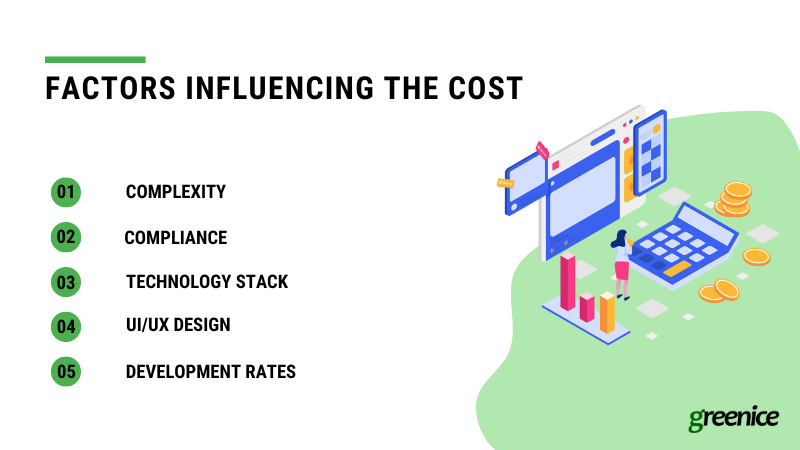
Complexity
This refers both to the complex logic of the application and complex functionality.
Complex business logic in a web application, which dictates how different components of the app interact and process data, significantly increases development costs. This complexity requires profound planning, specialized coding, and extensive testing to ensure seamless functionality and data handling. Moreover, customized solutions to fit specific business processes add to the development time and resources needed. Additionally, maintaining and updating such an application is more challenging and costly, particularly as it needs to scale and adapt to future business changes.
For example, our client, Exotic Racing, wanted to enhance customer flow which involved digitizing and automating their unique operational processes. We developed a dashboard integrated with their ERP system, enabling seamless synchronization of customer orders, instructor schedules, and car readiness—replacing outdated whiteboards. This system automates updates of customer tickets and tracks each step of the customer's journey, from check-in to check-out. The incorporation of complex business logic like real-time car readiness tracking significantly increased the development cost but improved operational efficiency and customer satisfaction by reducing wait times and increasing daily capacity.
The more complex functionality of the application, the higher the cost. Complexity can arise from the need for custom features, advanced data processing, or integration with multiple systems. For instance, a simple content management system would be on the lower end of the cost spectrum, while a complex application with real-time data analytics, machine learning capabilities, and high-level security features would be much more expensive. The same principle applies if you want to build an app like Amazon. Such a platform requires significant investment compared to a simple online store.
Compliance
Compliance with industry regulations and standards is a critical factor that can significantly affect the cost of web app development. Adhering to legal and security standards such as GDPR for data protection, HIPAA for healthcare information, or PCI DSS for payment processing not only requires thorough planning and implementation of complex security measures but also continuous monitoring and updating to ensure ongoing compliance. These requirements can lead to increased development time and the need for specialized expertise, both of which raise the overall project costs.
Technology stack
The technology stack chosen for web app development significantly influences the overall cost due to the complexity and scalability needs of the application. As the number of tools increases, so does the development time and the level of expertise required from developers, which in turn raises their rates. Let’s look closer:
- Static web apps, which primarily display fixed content, require basic technologies like HTML and CSS, and may or may not use libraries/frameworks like Angular, Vue, or Blazor for the front-end. These are relatively straightforward and less costly to develop.
- Dynamic web apps involve server-side technologies like PHP, Node.js, or Python, and front-end technologies like Angular and Vue along with database systems such as MySQL or MongoDB to manage interactive and frequently updated content, leading to higher development costs.
- PWAs require the most extensive technology stack, including service workers for offline functionality, manifest files for app-like behavior on mobile devices, advanced JavaScript frameworks such as React or Angular, and tools like Google Lighthouse or Workbox for their progressive features. This complexity makes PWAs the most labor-intensive and expensive to develop, as they aim to deliver a high-quality user experience comparable to native apps across all platforms.
UI/UX design
UI/UX design plays a pivotal role in determining the cost of web app development.
A simple and inexpensive design typically involves using standard layouts and minimalistic interfaces that focus on functionality without extensive custom graphics or animations. Think about straightforward forms, basic navigation menus, and template-based designs, which are quicker to implement and require less testing.
A fancy and expensive design incorporates custom-made elements, sophisticated animations, unique interactive behaviors, and possibly integration of advanced technologies like AR or VR. These designs often require detailed wireframes, extensive user testing, and collaboration between multiple designers to create a visually compelling and highly interactive experience. Such complicated designs not only enhance user engagement but also significantly increase development time and costs.
Typical designer rates on Upwork are $20-$40 per hour. But you should understand that fancy design means more hours spent on creating it and thus - higher costs.
Development rates
The cost of hiring developers varies based on their location, seniority, and the language they use:
- Location: Geographic location significantly impacts development rates due to differences in living costs and local economic conditions. For instance, developers in North America typically charge between $62 to $209 per hour, whereas those in Eastern Europe might charge $26 to $40 per hour.
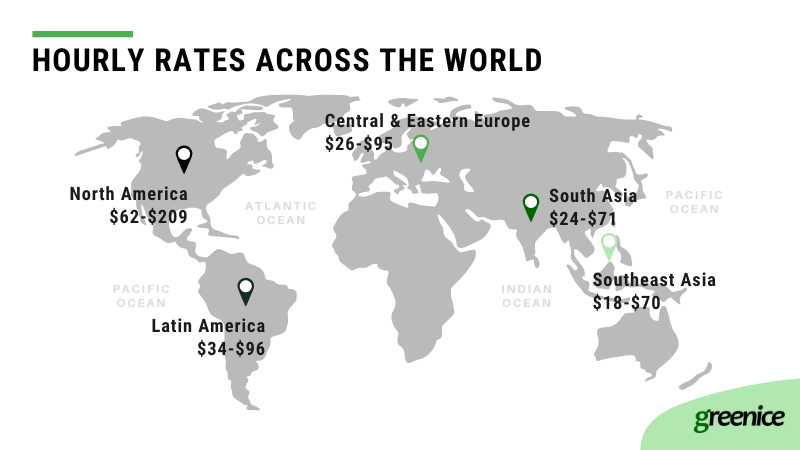
- Seniority: Experience level also affects rates. Senior developers or specialists in certain technologies might have higher rates but can offer the advantage of faster development times and fewer errors, potentially reducing long-term costs. Hourly rates can range from $15 per hour for junior developers to $45 per hour for senior or full-stack developers on platforms like Upwork.
- Programming languages: The cost can vary depending on the programming language chosen. For instance, developers skilled in less common languages like Scala or Zig may command higher rates due to the scarcity of expertise. According to the Stack Overflow Survey in 2023, hourly rates for languages like Zig ( $52 per hour) are significantly higher than more commonly used languages like JavaScript ($37 per hour) or PHP ($29 per hour).
Need expert guidance on your web app project?
Contact UsHow to cut web app development cost
While developing a web application can be costly, there are several strategies you can employ to keep expenses under control without compromising on quality. Here are some effective ways to cut costs during the development process:
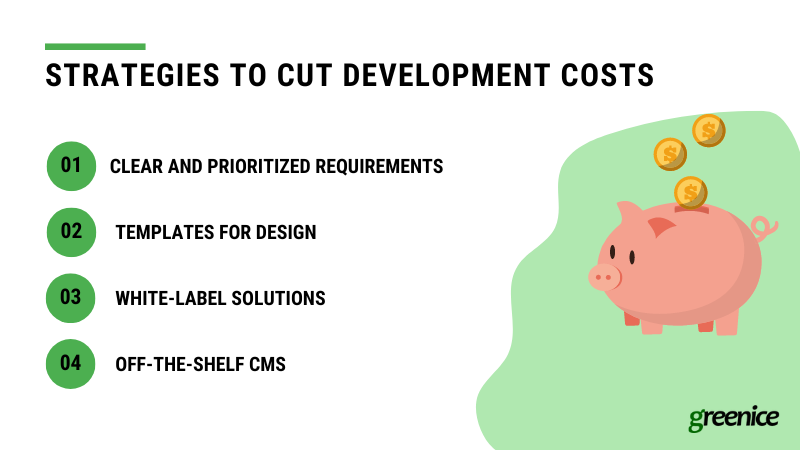
Clear and prioritized requirements
Having a well-defined and prioritized set of requirements is one of the most effective ways to reduce development costs. Here is how they can help:
- prevent scope creep, which is the unplanned expansion of project features, by clearly outlining what needs to be developed, ensuring the project remains on budget and schedule. For instance, specifying that a user login system should not initially include social media integrations prevents unexpected additions.
- lead to more efficient resource allocation and reduced wastage, allowing teams to focus on essential features first, thereby optimizing development time and costs.
- enhance project estimation and planning, improve stakeholder communication, and minimize the risk of costly rework due to miscommunications.
- aid in risk management by identifying potential challenges early on, enabling proactive solutions. For example, knowing in advance that the project requires complex third-party integrations allows teams to prepare and allocate resources more effectively.
This is why developing a detailed Software Requirements Specification (SRS) is essential. It guides the development team and ensures that every feature is aligned with business goals. Clear requirements prevent scope creep, where features are added on the fly, which often leads to budget overruns.
Such a document is usually produced during the Discovery Phase. So try not to skip this step.
Templates for design
Utilizing pre-made design solutions can significantly cut costs in the development process. Such templates are collections of reusable elements and screens that can be quickly adapted to your web app's design. By using these templates, you reduce the amount of time designers spend creating unique designs from scratch.
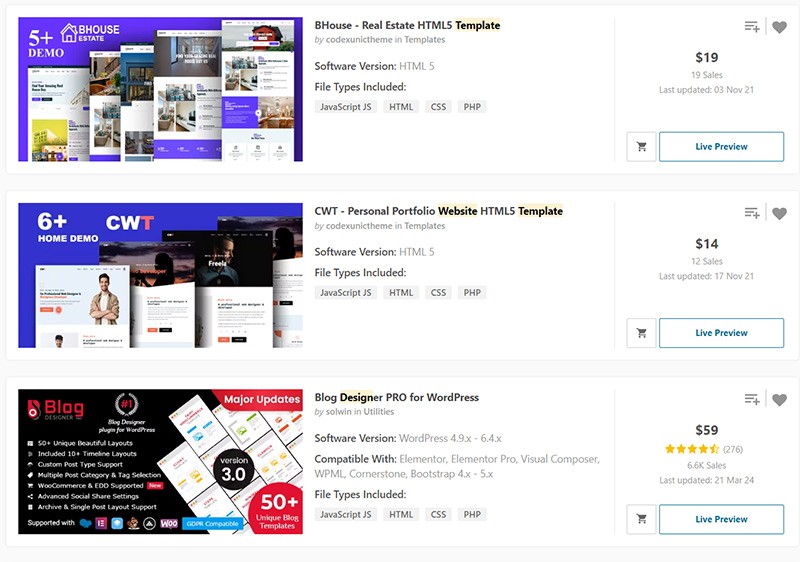
This approach also ensures that your application adheres to modern design standards. A well-chosen template can enhance the product's aesthetics and functionality without a hefty price tag.
White-label solutions
Utilizing white-label software can dramatically reduce development time and costs. These are pre-developed code scripts that you can add and customize to fit your specific needs. Since it is already built and tested, you save on the costs of development from scratch. This approach is particularly beneficial for standard applications like eCommerce platforms or content management systems, where the basic structure remains consistent across different uses.
For instance, there are scripts for multi-vendor marketplaces like Amazon that include all the basic features, reducing the cost for an MVP from $15,000 to $5,000. However, these solutions may not be suitable for everyone. If a white-label solution aligns with 70-80% of your project requirements and requires minimal modifications, it can be an excellent choice. If not, it might be more practical to start from scratch.
Off-the-shelf CMS
Choosing an off-the-shelf Content Management System (CMS) can be another option for businesses looking to save on development costs. Systems like WordPress, Shopify, or Joomla provide robust platforms that are relatively inexpensive compared to custom-built solutions.
These CMS platforms are ready to use, which significantly shortens the development timeline. You can have a fully functional site up and running in a fraction of the time it would take to develop one from scratch.
While off-the-shelf CMSs offer less flexibility than custom solutions, many are surprisingly adaptable and scalable. However, it's important to evaluate whether an off-the-shelf solution meets your long-term business needs as they can have limitations in scalability and customization.
Compared to off-the-shelf CMSs, white-label solutions allow for more customization and branding but require considerable technical expertise. While both are cost-effective and speed up market entry, off-the-shelf systems are simpler to use, whereas white-label options offer greater flexibility at the cost of higher technical demands.
Conclusion
In this article, we've discussed how various factors like business logic, technology choices, and design complexity can impact the cost of developing a web application. These factors highlight why understanding development costs is crucial for effectively managing your budget and ensuring your app meets your business needs.
Our deep experience, gained from completing over 200 projects since 2007, equips us to help you navigate these challenges efficiently. By working with us, you'll be better prepared to make informed decisions that align with your goals.
Ready to take the next step? Contact Greenice today to discuss how we can help develop a web application that drives your business forward.
Transform your business with a custom web app
Contact UsRate this article!
5







 Sign in with Google
Sign in with Google
Comments (0)